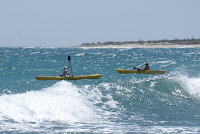Humpback Record 2010
El Cardonal Grid
Urmas Kaldveer, PhD., MioSah
This is the first year I have been here through the whole of a season from fall to spring. I was seeing Humpbacks traveling in the grid by mid-November in numbers large enough (2-5/day) to warrant a trip out to the grid. I went out twice during the month, once on the 14th and a second time on the 22nd. This resulted in 3 good IDs.
Due to weather conditions I was able to go out only twice more in January.
Jan. 14th 2 HBs (one ID # 4) and on the 18th no whales were encountered.
February, as usual, was a good month, best ever!
Feb. 1st, 14 HBs
Feb. 10th, 4 HBs
Feb. 17th, 7 HBs
Feb. 18th, 3 HBs
Feb. 20th, 4 HBs
Feb. 28th, 5 HBs
March was also very good with 30 encounters
Mar. 1st, 8 HBs
Mar. 4th, 5 HBs
Mar. 5th, 8 HBs
Mar. 14th, 2 HBs
Mar. 18th, 1 Blue Whale
Mar. 23rd, 2 HBs
Mar. 26th, 4 HBs
By April my research funds were expended but 8 encounters took place before the money ran out.
April 5th, 6 HBs
April 10th, 2 HBs
All together I had 80 encounters and I believe possibly 50 good IDs. There is no question but that this was the best year since I began the study in 2005. In fact, this year I had twice as many encounters and good IDs as any previous year.
As of the writing of this report, April 19th, I am still seeing HBs passing through the area almost daily. Usually mothers with calves but also groups of 2-4 males, displaying breaching, tail lobbing and pectoral slaps with great gusto!
An interesting note: at least 90% of my whales were moving south even at the beginning of the season.
In general the whales looked very healthy with mothers nice and rounded and calves with plenty of vigor. Males too showed excellent outward appearance.
It has been a very gratifying season because of the numbers, the health and the numerous times I have been in the water with them. I am somewhat concerned nevertheless, because a change in numbers this great, moving south etc raises the obvious question as to why? As we begin to approach a time of greater Oceanic change mitigated by Global Warming and Climate Change I am very sensitive to “Red Flags” in the biosphere. I would be extremely happy if it is all obsessive and unnecessary concern, but I think there is valid reason to be vigilant.
I sincerely hope that this data is of value. I am committed to the preservation of our migrating Cetacean friends.
Urmas Kaldveer, PhD
El Cardonal, BCS, Mexico
Here are some non ID photos to enjoy






My dear Brigiitte and Jean Luc who "adopted" me this year into their family

After my Whale Shark dive....satisfied!

No comments:
Post a Comment